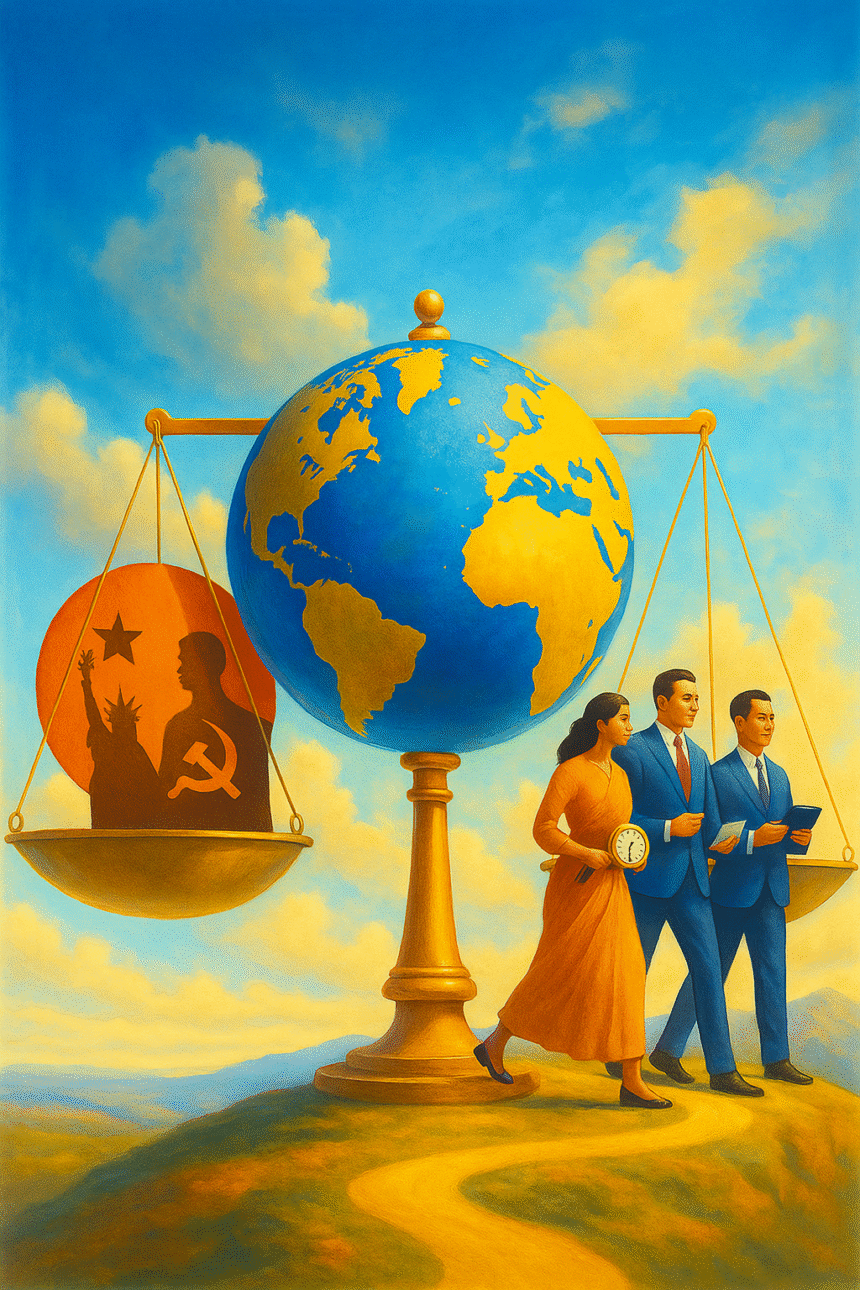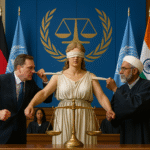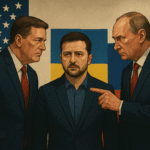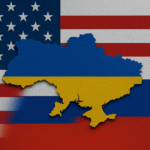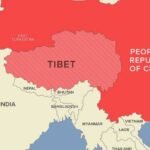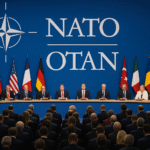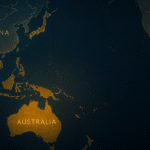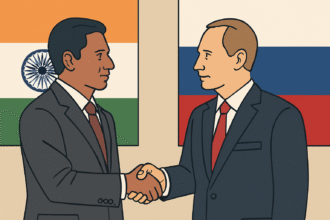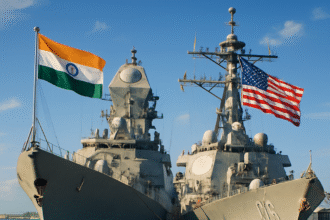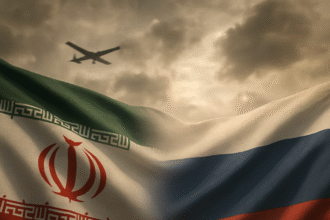In an age where major powers are locked in hardened stances—between Washington and Beijing, Brussels and Moscow—some of the most consequential decisions in global politics are no longer being made at the top. They’re being made in the middle.
From India to Brazil, Türkiye to South Korea, a coalition of middle powers is rising—not as a bloc, but as a mindset. These nations are declining to pick sides in a polarizing world. Instead, they are choosing agility over allegiance, ambiguity over alignment. In doing so, they are not sitting on the fence. They’re building their own.
A World Unfit for Simple Choices
The Cold War world thrived on binaries. So did the brief unipolar moment after 1991. Today’s global order, however, is defined not by clarity, but by contestation: of power, of rules, of legitimacy. The United States remains powerful but overstretched. China is assertive but distrusted. Russia is disruptive but isolated. And global institutions are increasingly fragmented.
Into this vacuum, middle powers are stepping not just to fill space—but to shape structure.
Strategic Ambiguity as Grand Strategy
Strategic ambiguity is not a lack of direction. It is deliberate non-commitment that preserves autonomy while maximizing engagement. It allows states to cooperate without being co-opted. To align tactically without being absorbed strategically.
Let’s look closer at how this plays out.
India: “Not Sitting on the Fence”
India’s foreign policy today is anchored in what External Affairs Minister Dr. S. Jaishankar calls “multi-alignment with clarity.” In practical terms, this means engaging all without being bound by any.
India is a central pillar of the U.S.-led Quad, shares intelligence and maritime exercises with Washington, and promotes a free and open Indo-Pacific. Yet it remains a major buyer of Russian arms and oil, has abstained from Western-backed UN resolutions on Ukraine, and is deeply invested in BRICS and SCO platforms—both China-inclusive.
At the GLOBSEC Forum 2023, Jaishankar responded to criticism with characteristic precision:
I am not sitting on the fence just because I don’t agree with you. It means I am sitting on my ground.
Dr. S. Jaishankar
India’s actions are not fence-sitting—they are assertion. Its foreign policy reflects a nation that sees itself not as a pawn in superpower games, but as a pole in a multipolar world. As the world’s fastest-growing economy and digital powerhouse, India’s strategy is one of interest-first realism—backed by democratic legitimacy and global aspiration.
Türkiye: Orchestrating Leverage Through Tension
No country embodies geopolitical opportunism more than Türkiye under President Recep Tayyip Erdoğan. Often unpredictable, Ankara’s moves are rarely accidental.
Türkiye remains a key NATO member, hosts U.S. nuclear assets, and contributes to alliance operations. Yet it has purchased Russia’s S-400 missile system, blocked Sweden’s NATO membership until securing political concessions, and brokered grain deals with Moscow and Kyiv alike.
In Syria, it hosts millions of refugees while threatening military action against Kurdish groups. In Libya and the Caucasus, it extends its influence through drone warfare. In energy, it’s a conduit between Caspian producers and European markets.
Türkiye’s strategic ambiguity flows from geography and ambition. As the bridge between Europe and Asia, Black Sea and Mediterranean, NATO and Eurasia, Ankara has transformed its location into a bargaining chip. It frustrates allies but remains indispensable.
As one Turkish analyst noted in Foreign Affairs, “Türkiye is not leaving the West. It’s negotiating better terms within it.”
Brazil: A Green Power with Multipolar Reach
Brazil’s ambiguity rests on two pillars: economic leverage and moral framing.
Under President Luiz Inácio Lula da Silva, Brazil has refused to isolate China or Russia, deepening trade with both while presenting itself as a champion of the Global South. It calls for peace in Ukraine without endorsing NATO’s position and urges reform of global governance without aligning with authoritarian models.
At the same time, Brazil is repositioning itself as an environmental superpower. It is home to the Amazon, the world’s largest carbon sink, and has used that fact to reclaim a leadership role in global climate diplomacy. Lula’s government hosted COP30 negotiations and has made rainforest preservation a tool of both moral leadership and foreign policy leverage.
South Korea: Navigating the Peninsula and the Pacific
Sandwiched between two giants—China and Japan—and under the umbrella of U.S. defense commitments, South Korea might appear locked into alliance politics. But Seoul has consistently shown how a middle power can navigate contradictions with quiet sophistication.
It maintains strong military and intelligence ties with the United States, even hosting THAAD missile systems to counter North Korean threats. Yet China remains its largest trading partner, and South Korea has repeatedly resisted pressure to decouple economically from Beijing.
South Korea’s real influence, however, lies in its soft power and technological primacy. It dominates global semiconductor supply chains, shapes digital culture through K-pop and cinema, and is emerging as a regulator and innovator in AI, robotics, and bio-tech.
The administration of President Yoon Suk-yeol has pledged deeper strategic alignment with the West, but Korean diplomats continue to balance commercial and security interests with measured ambiguity. Its model is one of dual credibility: trusted by allies, tolerable to rivals.
Strategic Ambiguity: A Risky But Rewarding Game
For all its advantages, ambiguity carries risks. Superpowers may perceive middle powers as unreliable or opportunistic. India’s tightrope between Russia and the U.S. has led to frustrations in Washington. Türkiye’s behavior has resulted in temporary U.S. sanctions and EU estrangement.
Domestic volatility is another factor. Leadership transitions, populist swings, or economic downturns can disrupt continuity and force alignment decisions prematurely. Furthermore, ambiguity can be misread as weakness—inviting pressure or manipulation.
Yet for now, the benefits outweigh the risks. In an unstable world, middle powers are managing to do what superpowers often cannot: build trust without dependence, assert interest without provocation, and influence without domination.
Redefining Global Influence
The middle powers of today are not merely adapting to a broken order. They are quietly redesigning it.
They are building issue-based coalitions, reimagining climate and trade governance, and inserting regional voices into global platforms. The Indo-Pacific Economic Framework, BRICS expansion, and African Union’s Agenda 2063 are all spaces where middle powers are not just present—but pivotal.
What strategic ambiguity reveals is a deeper truth: in this century, the rules won’t be rewritten by those who shout the loudest—but by those who understand when to speak, when to listen, and when to say “no” without saying it directly.

